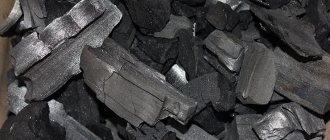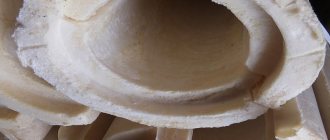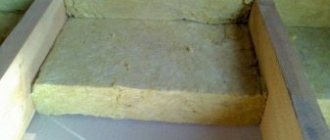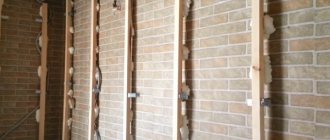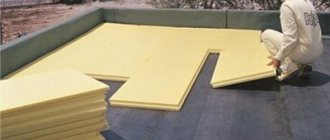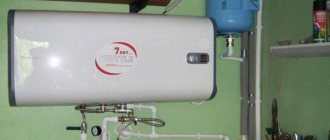A draft-free house that retains warmth for a long time in winter and coolness in summer is a reliable material basis for family coziness and comfort. High-quality thermal insulation allows you to reduce heating and air conditioning costs. A relatively new method of insulation, used since the end of the last century, is spraying foam insulation. The method allows you to achieve ideal compaction of surfaces and joints of all building structures. The eco-friendly coating can be removed without much effort if necessary.
Types of coatings
In civil engineering, two main types of foam are used for insulation: based on penoizol and based on polyurethane foam.
Penoizol
Penoizol belongs to the group of foamed plastics and, after hardening, forms a fine-cell, low-elastic spatial structure. The chemical basis of plastic is urea polymers. Penoizol is supplied in the form:
- liquid composition for spraying;
- molded flat slabs;
- granules for filling voids.
Penoizol is perfect for insulating frame buildings. It actively foams and fills the gaps between:
- internal and external walls;
- sheet panels (gypsum board, plastic, OSB) and walls;
- rough and finishing floors.
The progressive material is widely used for thermal insulation of pipelines for various purposes.
Its main advantages are:
- high application productivity;
- resistance to temperature and moisture;
- long period of operation;
- low flammability;
- elasticity and resistance to deformation.
Applying foam to a wooden house
It is not susceptible to mold and is unpalatable to rodents. Like other foams, it perfectly absorbs noise and dissipates vibrations.
Polyurethane foam
Foamed polyurethane forms a closed-cell structure when hardened. This increases the strength of the material compared to conventional construction foam. It is applied in a layer of 5-10 cm and has good adhesion to the base materials:
Thanks to the closed shape of the microcells, it practically does not absorb liquid and itself serves as a means of waterproofing. It is used both outside and inside buildings.
The main advantages of penoizol are:
- low specific gravity;
- high fluidity in liquid and foam state, the ability to fill cavities and gaps of any shape and width;
- low vapor permeability;
- biological stability, repelling mold and rodents.
Thermal insulation of internal walls
The material also has a disadvantage: to use it you will have to buy a special sprayer and container.
Polyurethane foam
A low-cost method of thermal insulation is the use of spraying conventional construction foam to insulate floors and walls. This can give an economic effect when insulating relatively small volumes and areas, for example, during repairs or minor redevelopment. If we are talking about the construction as a whole, the savings will quickly disappear. Polyurethane foam is often used to fasten sheets of solid foam insulation, to fill joints and gaps between them.
Filling with polyurethane foam into frequent sheathing
There are special brands of polyurethane foam with high adhesion on the market, specially designed for fastening sheet materials. With their help, insulation of floors and walls with construction foam is carried out quickly, and joints are filled reliably.
Thermal insulation paint
In addition to foaming materials, there is also another liquid heat insulator - ceramic paint. It is used on stone, brick, foam concrete surfaces as a complex coating that serves for:
The main purpose of this paint is moisture insulation. The insulation effect is concomitant. To achieve an insulation effect comparable to a 20 mm layer of penoizol, such paint will have to be applied in at least 10 layers. The paint is excellent for vapor barrier of complex joints of building structures that are difficult to protect from moisture in other ways.
Ceramic Thermal Insulation Paint
Application area
Polyurethane foam has excellent sealant properties, and therefore polyurethane foam is often used to fill voids with your own hands, as well as for processing thermal seams in panel houses, sometimes in road construction. In addition to this function, which is to create a thermal insulation effect, the use of polyurethane foam makes it possible to solve some other important problems for operation. With its help, it is possible to create high-quality sound insulation, and the wall receives an excellent protective coating that protects the coating from mechanical damage.
Quality is also important, since polyurethane foam can be used in places that cannot be insulated with other insulation materials due to the design of the building. For example, processing gaps where it is not possible to use roll and slab insulation, and to use granular materials will require dismantling the roof or part of the wall.
In addition, the use of polyurethane foam makes it possible to improve the appearance of the wall and get rid of defects, and due to the fact that the material is aesthetic, the layer will not crack when the structure shrinks and will retain its properties fully.
Advantages
Let us note the advantages of filling voids with polyurethane foam:
Among all similar materials, polyurethane foam has the lowest thermal conductivity coefficient.- The coating has a monolithic structure, in which there are no seams or cracks.
- Provides high quality noise insulation.
- The material has neutral biological indicators.
- Polyurethane foam is resistant to mold and various fungal formations, and also does not attract rodents.
- The material has a service life of 30 years.
- Can be used even in hard-to-reach places.
- Retains its thermal properties during the entire period of operation.
- It is vapor permeable and resistant to mechanical impacts.
- There is no shrinkage.
- Has high adhesion rates.
These are excellent characteristics for a thermal insulation material.
Myths about the dangers of foamed plastics
Conspiracy theorists and unscrupulous advertisers of competing classes of insulation products often spread rumors about the terrible health risks caused by foamed plastics.
If you look at it without hysterics and exaggeration, polyurethane foam actually has one property that carries a potential threat.
When burned, it can form toxic volatile substances based on formaldehyde resins. During a fire, this may be an additional risk factor for those who did not have time to leave the burning premises.
During application of the foaming composition, some inert gas and other chemical compounds are also released.
However, after the foam coating has completely hardened for the entire period of its operation, no harmful emissions occur. The complete film surrounding each microcell is chemically inert and impermeable.
To summarize, we can say that the foam coating is completely safe during operation.
During application, all precautions specified in the user manual should be observed:
- use only serviceable equipment;
- exclude the use of open fire and high-temperature heating devices during application;
- use personal protective equipment: respirator, gloves, protective overalls with a hood and thick shoes;
- When working indoors, ensure ventilation
- do not use the premises for people to stay in them until the composition has completely hardened (usually 24 hours.)
Operating principle of the equipment
Equipment for pouring polyurethane foam is divided into 3 categories according to the method of application.
According to this criterion, installations are divided that during operation perform:
- Low pressure.
- High pressure.
- Foam generators.
Models that operate at high pressure do not use compressed air during application.
Equipment of this type has a number of advantages:
- High performance.
- The dosage is accurate.
- Operation is simple.
- Mixing of components is carried out perfectly, which has a good effect on the quality of the resulting material.
- You can spray polyurethane foam in small portions.
- Due to the airless application method, the formation of fine particles in the room is minimized.
Disadvantages include difficulty in maintenance and high price of materials. Low pressure models use compressed air.
The advantages of such installations are as follows:
- Reasonable price for components.
- Easy to maintain.
- Simplified design.
Among the disadvantages, we highlight the high consumption of polyurethane foam and not entirely accurate dosage. And a separate category is the foam generator, which mixes components using air, which is supplied using special compressors.
Popular equipment, cost and characteristics
High-performance universal installations for spraying foam coating at a professional level cost hundreds of thousands of rubles. It makes sense to purchase them if you plan to open a thermal insulation business. They won't pay for themselves on just one house.
Household-grade devices are cheaper; they are divided into two classes:
Disposable
This is a factory assembled unit with charged components. Her virtues
- minimal preparation for work and ease of use;
- low price;
- After use there is no need for washing and preservation.
- fixed volume of composition and, accordingly, area covered during use;
- An accurate calculation of the purchased kits is necessary - there may not be enough or there may be extra ones left.
It makes sense for novice craftsmen who do not want to waste time dealing with settings, refueling and maintenance of a reusable unit.
Rechargeable
This is a full-fledged complex for applying viscous coatings, which, unlike professional ones, has limited productivity and resource. They allow you to independently choose the type and density of the mixture, and charge the strictly required amount into the cylinders.
ProtonHome
- A popular rechargeable unit costs from 25 thousand rubles.
- allows you to spray coatings of any density,
- productivity - 2 kg of mixture per minute, which corresponds to 25-30 m2 with a thickness of 2 cm.
- the cost per square meter of coverage is approximately 560 rubles, the lowest among analogues.
- Cheapness results in the absence of fine adjustments of process parameters.
- A good choice for beginners.
Home installation Proton Home
Air-Light
A more productive (up to 4 kg of mixture per minute) universal rechargeable unit allows you to work both with built-in cylinders and to remove components from 100- and 200-liter barrels. Equipped with a frame and wheels for easy movement around the construction site. It is wise to purchase if large volumes of foam insulation are expected
Cost - from 80 thousand rubles.
Mobile installation AirLight
Foam Kit 600
Kit for applying 56 m2 of coating, disposable, pre-configured.
Disposable Foam Kit 600
Costs from about 35 thousand rubles, the kit includes everything you need to apply the composition charged into the cylinders, including replacement nozzles for the gun and protective gloves.
Criteria for selection, how to determine the best
To make the right choice, you need to know the main characteristics:
- output volume, i.e. how many liters of foam will be obtained from one cylinder;
- primary expansion, i.e. how much will the volume of foam increase in the first minutes after release; optimally the indicator should not exceed 30%;
- secondary expansion, i.e. final increase in volume after polymerization, low secondary expansion eliminates deformation of structures;
- adhesion - the ability to adhere to a working surface; high-quality products have adhesion to a wide range of materials.
Professional mounting foam TECHNONICOL 240 fire-resistant 1000 ml. Photo Petrovich
In addition, it is necessary to determine the purpose of the foam - for domestic or professional use and the conditions of use - the ambient temperature when performing work.
Insulation process
Do-it-yourself foam coating is within the capabilities of a home DIYer with basic spray painting skills. When working with entry-level household installations, as a rule, one person can handle it. When installing sheathing and when working with high-performance devices with long hoses, an assistant will be required to carry them, as well as move containers with components.
Preparing to start work
Before you begin, you need to prepare the surface for coating. You should remove old wallpaper, paint and anything that might prevent the foam from adhering to the surface.
Next, in increments of 50 cm, vertical guides are attached to the wall - wooden blocks or a metal profile. They are designed for fastening finishing materials - drywall, lining or others. If there is no decorative coating, the guides are not installed and the foam is sprayed in a continuous layer.
All work on laying communications - electrical and pipelines - must be completed before spraying begins. It is recommended to lay wires in corrugated plastic or metal sleeves.
Before you start covering the wall with foam, you should also make sure that there are no air bubbles left in the hoses and cylinders.
Continuous wall covering
Fill
First, fill all joints, junctions, cracks and cavities with foam. This way you can get rid of unwanted voids left between structures and finishing materials at previous stages of construction. When insulating the cavities remaining between the walls with polymer foam, several holes are made in them. Foam is blown out on one side; when it appears from the control holes on the opposite side, the blowing is stopped.
If the sheathing is installed, the places where it adjoins the wall are also passed first.
Applying foam to the wall is carried out with smooth, sweeping movements. Vertical surfaces are covered from bottom to top.
First, the joints and junctions are covered.
If pipelines are coated, they must be protected from corrosion before starting work by cleaning, degreasing and applying an anti-corrosion coating.
Next, the spaces between the sheathing are filled. An assistant carries the hoses of a high-performance unit
Once the foam has been applied and cured to an external or internal wall, it can be plastered and then painted.
Household and semi-professional foam - compare 2 options
Due to its ease of use and good characteristics, foam in cylinders is widely used in private construction and during various renovations in the apartment. For example, when installing window blocks, doors, and insulation. Foam cylinders are equipped with a special plastic tube, or come in a design for a special gun.
Using cylinders with a plastic tube is the simplest option. Excellent for solving point problems with small volumes of work. But there are also disadvantages. The foam output is not adjustable. Its quantity must be selected by adjusting the pressing force experimentally. When working with a balloon, you have to make the most of its volume, since the foam in the plastic tube, like that applied on the surface, begins to react and harden.
Characteristics and features of use:
- cylinder capacity 300 ml and above;
- the yield is average, part of the component remains unused, as a remainder;
- a significant increase in volume, almost twofold;
- shrinkage after drying 5-7%;
- no additional tools required;
- one-time use;
- small amounts of work.
Foam cylinders designed for a special gun are more convenient to use. It does not take much time to replace a used cylinder with a new one. Therefore, they are often called semi-professional. The gun is installed on the cylinder by screwing it into a special thread on the cylinder head. The tip of the gun pushes through the safety membrane and the foam enters the gun.
Convenient adjustment allows you to easily control the foam output. The presence of special protective mechanisms prevents its contact with air and, as a result, hardening. Therefore, it is better to store the started cylinder with the gun attached. In case of malfunctions, the gun can be easily disassembled and its internal structure is washed with a solvent. The scope of application of such foam is much higher. Characteristics and features of use:
- cylinder capacity 700 ml and above;
- complete yield, almost no residue;
- expansion is minimal;
- shrinkage after drying 0-3%;
- you need a special gun;
- repeated use;
- Suitable for spot applications and large surfaces.
How to choose material
There is a wide range of foam insulation materials on the market. European foam insulation intended for walls guarantees high quality, but has a high price. Domestic manufacturers have well mastered the production of licensed compounds and materials of their own design, which provide decent quality thermal insulation and a guaranteed service life at a significantly lower price. Experts highlight such manufacturers as
Their advantage over nameless Chinese crafts is their precisely known composition and quality control at all stages of production.
Survey
Ratings of the best polyurethane foams are compiled by various experts, whose opinions are subjective. This article analyzes those brands that Internet users are interested in. But the demand for individual brands and formulation options does not demonstrate the high quality of the products. Therefore, we will try to find out which brands of polyurethane foam are really the best. To do this, below is a survey in which any visitor to our website can take part. You can explain your choice in the comments.
Foam for wall insulation: types and features
To insulate walls, modern craftsmen use various materials and technologies. They have significant differences among themselves, but they are all designed for the same purpose - to make the thermal insulation of the house as productive as possible.
Liquid foam for wall insulation is called polyurethane foam (PPU).
All the necessary ingredients are mixed at the factory and the composition required for polymerization is kept under high pressure in cylinders. In order for the foaming and hardening reaction to occur, contact of this composition with oxygen is necessary.
Is it worth insulating walls with foam? Of course, it’s worth it for one simple reason - polyurethane foam is an ideal material for this purpose, and besides, it performs another very important function - sound insulation.
What is foam insulation? This is a special pliable mass that, when interacting with air, tends to foam. This composition has a fairly strong and elastic structure. To spray it, cylinders, pneumatic devices and other devices are used.
Today, when constructing frame-type houses, the areas between the “sandwich panels” are filled mainly with foam insulation.
Polyurethane foam in construction
PPU is a substance made of polyurethane 85-90% filled with gas (air). Such insulation or sound insulation is very convenient in all construction industries, since after hardening it can only be removed mechanically (scrape, cut) - it almost does not react to various solvents and alkalis.
Features of brickwork
Types of well masonry Source kirpichdelo.ru
Pay attention to the image above - you see three options for well brick masonry. This is how the vast majority of brick walls are built, the thickness of which is either 510 or 640 mm - these two sizes are determined by the geometric parameters of the material: for ordinary (building) brick they are 250x120x65 mm. That is, a thickness of 640 mm means that the wall on the street side was built with one and a half stones, and the inner wall with one.
You may think that this is done to increase the load-bearing capacity of the walls, but this is not so. All the ceilings of a five-story building from the time of N.S. Khrushchev can be easily supported by a wall 250 mm thick, that is, one brick. The construction of well masonry is necessary to insulate the house - the voids formed during the construction process are themselves insulation, since air is the best insulation from heat and cold. However, such protection has always been strengthened before; this was mainly done with coal slag and ground beetles, which accumulated in abundance in boiler houses with solid fuel equipment.
Advantages and disadvantages of foam insulation
The main advantages of insulation:
- Possibility of processing even large areas in a short period of time.
- The coating has no seams.
- This material is not subject to rotting processes, and mold and mildew do not form on it.
- This is a highly flammable material that is not subject to combustion, it can only melt.
- By interacting with the metal coating, a dense anti-corrosion protection is created.
- The result is a smooth surface, which is characterized by excellent heat-saving properties.
- The foam does not deform the base on which it is applied.
- Light weight.
Regarding indicators such as environmental friendliness and durability, I would like to say the following: the material is absolutely safe for long-term use in residential premises.
Disadvantages inherent to this type of insulation:
- It is negatively affected by direct sunlight.
- The material may become unusable from continuous contact with water.
- The product is not cheap.
- To apply it, special conditions must be created.
- When working with foam insulation, you need to use a special tarpaulin suit, gloves, a respiratory mask and safety glasses.
- Since this material has a low level of vapor permeability, phenomena similar to those occurring in a thermos occur inside the building. Therefore, it is imperative to install a forced ventilation system for the premises.
Features of using the material
In terms of its physical properties, polyurethane foam is a thermosetting plastic mass, which has a cellular structure. The material has strength, this is due to the crystalline solid structure, which makes up only 3% of the total mass. 97% of the mass consists of cavities and pores, which are filled with gas having a low thermal conductivity. Polyurethane foam is formed by mechanical mixing of components. In this process, the two components enter a single chamber and are mixed, making sure to exclude compressed air.
The PU foam composition at the end after production has the appearance of a smooth elastic stream. The moment contact between the components begins, a chemical reaction occurs and its result is the formation of a polymer called polyurethane. During the reaction, carbon dioxide is released and heat is generated, and the former contributes to the porosity of the structure, and thanks to the heat, the foam rises. Thanks to this, the final product is obtained.
What is the best way to insulate a building with foam - from the outside or from the inside?
It is difficult to give an unambiguous answer to this, but we will try to do so. One of the varieties of liquid foam, penoizol, is used for thermal insulation of frame buildings . This material fills the air gaps between:
- external and internal walls;
- wall and plastic panel;
- a wall and a sheet of drywall;
- subfloor and floor covering.
Insulation outside and inside
Using polyurethane foam, slabs made of solid thermal insulation materials are fixed, and the seams between them are also filled with foam.
Some homeowners use foam to insulate the facade of their building.
Polyurethane is used to eliminate minor defects on walls.
Video description
Pouring polyurethane foam using a household installation.
Insulation of attics and attics
Polyurethane foam can be used for attics, attics and ceilings Source foamkit.ru
You may have the impression that to fill polyurethane foam you definitely need space between two vertically constructed planes, but this is not so. If you have the right equipment, liquid thermal insulation can be poured onto exposed vertical and inclined planes, as shown in the top photo. After all, in essence, laying the foam substance here is no different from applying polyurethane foam, only there is no such powerful expansion effect. Therefore, to insulate an attic or attic, polyurethane foam is applied to the walls, roof and floor, and after drying it is covered with facing materials. When the foam hardens on the floor between the beams, you can even walk on it to lay the floor.
Note: pouring polyurethane foam for insulating houses has one drawback: this will require special equipment, and the foam itself must be ordered in containers, based on the volume of voids to be filled.
Types of foam insulation: polyurethane foam and polyurethane foam
There are a large number of different types of foam materials on the market for construction needs; we will not consider them all in detail. For example, let's take just a few of them, which are considered the most popular and effective. We will talk about polyurethane foam and polyurethane foam.
Polyurethane foam is used for:
- Achieve good sound insulation effect . To do this, fill the joints between pipes and holes in the wall with foam. Thus, it is possible to significantly reduce the noise level from the heating system, plumbing and operating air conditioners.
- Needs thermal and waterproofing . Using polyurethane foam, you can thoroughly seal cracks in the roof, voids around pipes, as well as empty space created as a result of installing door and window frames. The main purpose of polyurethane foam is sealing.
- Bonding . With its help, you can firmly connect various elements made of different materials to each other.
PPU is produced in cylinders and has the following features:
- Polyurethane foam has excellent thermal insulation properties . Therefore, it is widely used as insulation and sealing material in construction.
- The properties of this material directly depend on the additives used in its production.
- Using sprayed polyurethane foam, you can easily and without any problems insulate a structure of any shape . The material is not afraid of dampness, it withstands the effects of acids and alkalis. It is also too tough for rodents and various insects.
Rating of the best...
...for a pistol
Various sources and customer opinions allow us to imagine the following options for a pistol:
- Makroflex PRO, 750 ml;
- Tytan 65;
- Penosil Gold Gun 65;
- Krass Professional V69;
- Profflex PRO GOLD.
…by quality
Performers of various skill levels note the following compositions:
- Soudal Soudafoam;
- TECHNONICOL 65 Constant;
- Tytan O2;
- Makroflex WhiteTeq PRO;
- KUDO Gun FOAM 45+.
...by density
Density is an important parameter. For household options, the normal indicator is a density of 1525 kg/cub.m., for professional ones – 2535 kg/cub.m.
- TECHNONICOL 65 Constant;
- Peter Paul 65 years old;
- TECHNONICOL Master 50 all-season 750 ml.;
- Soudal Soudafoam;
- Tytan O2.
...to fill voids
Foam is used in a wide range of jobs; for filling voids, the best options, according to various sources and in accordance with the interest of Internet users, are:
- Makroflex Standard;
- ABSOLUT PROFF 70+ ARKTIKA NORD;
- Profflex PRO RED 65 PLUS;
- OGNEZA EI 240;
- Penosil Premium Fire Rated Foam B1.
...for insulation of PVC windows, balconies and more
- KUDO ABSOLUT PROFF 65+ ARKTIKA 1000 ml winter;
- Profflex PRO GOLD;
- Krass Home Edition;
- Soudafoam Low Expansion Gun;
- TECHNONICOL 65 Constant.
…top 10
Polyurethane foam MAKROFLEX Original professional all-season 750 ml. Photo by Maxidom
It is difficult to determine the 10 best options for polyurethane foam, since depending on the skills of the contractor, the specifics and conditions of the work performed, as well as other components, the optimal solution will be different compositions, so we will list the brands:
- TECHNONICOL;
- Makroflex;
- Tytan;
- Soudal;
- Penosil;
- Profflex;
- KUDO;
- NULLifire;
- Axton;
- Moment.
wall pie
Construction of a wall “pie” of a frame house:
- interior decoration;
- vapor barrier layer;
- insulation;
- frame stand;
- windproof layer;
- transverse lathing;
- vertical lathing;
- external finishing.
If you plan to insulate the premises from the inside, you need to carry out all the work in stages. One of the main issues that you should pay special attention to is the correct placement of the vapor barrier film in the thermal insulation “pie”.
Vapor barrier can be made from:
- reflective film;
- diffusion membrane;
- steam condensate film.
When installing a vapor barrier material, you need to take into account one important point: it must be mounted on top of the insulation on the room side. If you plan to insulate the wall with polyurethane foam, then you will not need a vapor barrier.
Popular manufacturers
Polyurethane foam became widespread in Europe in the late 80s. It appeared in Russia a little later. By 2022, a number of manufacturers that are popular with buyers can be identified:
- Penosil (Estonia);
- Illbruck (Germany);
- Kim Teс (Germany);
- Makroflex (Estonia);
- Soudal (Belgium);
- Proflex (Russia);
- Kudo (Russia);
- "Moment" (Russia).
Among these manufacturers, Russian products are most often purchased. It is not inferior in quality to foreign analogues.
Installation of lathing and applying foam yourself
It is necessary to screw an aluminum profile to the ceiling and walls in vertical rows . Next, the sheathing is strengthened using horizontal jumpers ( steps of 0.5 meters ). Don't forget to screw the profile around the perimeter of the window doorway.
In order not to stain pipes and communications, they need to be covered with film .
Rules for applying foam insulation in cylinders:
- First of all, you need to take care of safety precautions.
- Then you need to spray a small amount of automotive silicone grease onto the mounting gun.
- Next, you need to insert the can onto the gun and screw it tightly.
- Now you can apply the mounting foam to the desired location.
- The can must be removed from the gun and cleaned with a special compound.
- If the foam is not completely used up, you need to wash the valve located on the cylinder with a cleaner.
Applying foam to wall surfaces
What to look for when purchasing
High quality is indicated by:
- the condition of the packaging, the absence of mechanical and chemical damage demonstrates that the storage was carried out under proper conditions;
- shelf life, the “fresh” the foam, the higher the characteristics it has;
- The uniformity of the composition can be determined before use; it is necessary to turn the container over several times and shake it; if the contents of the container flow smoothly, then the material is of high quality;
- color, high-quality products have a light yellow color, darkening indicates the beginning of the polymerization process; however, companies offer compositions in other colors.
Waterproofing
Polyurethane foam is also used for waterproofing. It increases in volume under the influence of moisture and hardens within 24 hours.
Polyurethane foam with waterproofing properties is sold in cans. It is endowed with high waterproofing and fixing properties. It is used for both external and internal work.
This universal material is not afraid of water and high humidity, so it is widely used in everyday life.
Characteristics of installations for pouring polyurethane foam
Equipment for spraying and pouring polyurethane foam UZK-10 and UZK-20 have high performance indicators with relatively small sizes. Such installations make it possible to perform both spraying and filling. The devices have an improved filling head, which, in addition to a long service life and reliability, is characterized by smooth power adjustment. Such equipment has a timer, which makes it possible to feed polyurethane foam into the mold in the required quantity. Due to the low weight of the structure, operation is simplified. Such installations can be easily moved by one person.
The basic configuration includes a spray gun, which makes it possible to perform high-quality spraying. The reliability of the installation is ensured by a three-phase motor. The control panel has a power regulator and a remote control. The presence of a timer makes it possible to set the exact time for pouring the mass while accurately determining the volume and mass of the final product. This function helps prevent overfilling or underfilling, which reduces losses.
This one also specializes in the performance of casting installations. The company's products include such individual models as PGM-30AT, PGM-45AT and PGM-75AT. Such devices are equipped with tanks with increased capacity, which have an automatic heating function. They create pouring by molding products with a volume of 0.4, 0.6 and 1 m3. The company also specializes in the manufacture of equipment with universal use, namely installations with which you can both pour material and spray it. These are PGM-18M, PGM-18S, PGM-36S, PGM-20AT, PGM-20BN, PGM-27M, PGM-10BN, PGM-27S, PGM-36M, PGM-10AT. These devices are distinguished by their simplicity, as well as the fact that they can be set to the required proportions of the material.
Conclusion
Foam insulation can be used for walls made of various materials, including aerated concrete, blocks and reinforced concrete panels. Therefore, they are used for insulation of private cottages and apartments. Before giving preference to any one type of foam, consult a specialist.
If you have decided to insulate your house with liquid foam, this is the right intention. Always try to buy raw materials from the best domestic and foreign manufacturers. This way you will be able to avoid premature wear of structures.
Lightweight brickwork is a questionable decision!
To reduce the cost of building materials and, in particular, bricks needed to build houses, lightweight or well masonry walls were developed. Its essence lies in the fact that two walls are erected, as it were, one half-brick, which serves as an external cladding, the second is a load-bearing structure.
Between these two surfaces there is an air circuit. It is this air cushion, in this design solution, that plays the role of insulation. This solution allows you to reduce the amount of brick needed to build walls. True, the reliability of the walls is reduced, and in terms of insulation, not everything is clear here.
It should be noted that lightweight masonry is used mainly for the construction of low-rise buildings, or, in extreme cases, the upper floors of multi-story buildings, because the loads that such structures can reliably withstand for a long time are very, very limited.

